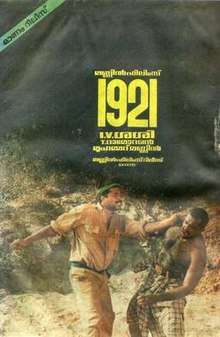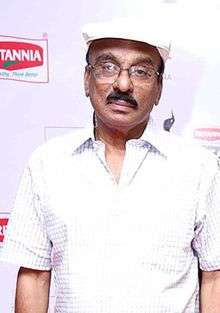1921 (1988 film)
1921 – Ayirathi Thollayirathi Irupathi Onnu is a 1988 Indian war drama film written by T. Damodaran and directed by I. V. Sasi, set during the 1921–22 Mappila Uprising in Madras Presidency. The film has an ensemble cast including Mammootty, Madhu, Suresh Gopi, T. G. Ravi, Seema, Urvashi and Mukesh.[2][3][4] It tells the fictional story of Khader (Mammootty), a World War I veteran, who joins with the Mappila rebels during the Uprising.
| 1921 | |
|---|---|
 Theatrical release poster | |
| Directed by | I. V. Sasi |
| Produced by | Muhammed Mannil |
| Written by | T. Damodaran |
| Screenplay by | T. Damodaran |
| Story by | T. Damodaran |
| Starring | Mammootty Madhu Suresh Gopi T. G. Ravi Seema Urvashi |
| Music by | Shyam |
| Cinematography | V. Jayaram |
| Edited by | K. Narayanan |
Production company | Mannil Films |
| Distributed by | Mannil Films |
Release date |
|
Running time | 197 minutes |
| Country | India |
| Language | Malayalam |
| Budget | Rs. 1.20 crore[1] |
Made with a budget of Rs. 1.20 crore, 1921 was then the most expensive film in Malayalam.[5][1] The film was released in Kerala on 19 August 1988 during Onam festival.[6][7] The film won Kerala State Film Award for Best Film with Popular Appeal and Aesthetic Value.[8][9]
Plot
The film focuses on Mappila bullock cart driver Khader (Mammootty), a retired corporal and World War I veteran, and Unni Krishnan (Suresh Gopi), a hardline nationalist revolutionary from a family of upper-caste Hindu landlords. Both men join the brigade of Variyan Kunnathu Kunjahammad Haji (T. G. Ravi), one of the prominent leaders of the 1921 Uprising.
The plot gradually introduces a variety of characters, representing the South Malabar society of the 1920s. The film also touches various social dilemmas which led to the 1921 Uprising, the atrocities committed by the British army and the rebels during the events and the eventual collapse of the rebel unity and organisation.
Cast
- Mammootty as Khader
- Madhu as Ali Musliyar
- Suresh Gopi as Unnikkrishnan
- T. G. Ravi as Variyan Kunnathu Kunjahammed Haji
- Seema as Radha Varma
- Urvashi as Thulasi
- M. G. Soman as Shekharan Varma (Captain, discharged)
- Mukesh as Haidru or Haidrose
- Ratheesh Rajagopal as Lavakkutti
- Bahadoor as Kattilasseri Muhammad Musliyar
- Kollam Ajith as Kunjalavi
- Tom Alter as R. H. Hitchcock Sahib (District Superintended)
- K. P. Ummer as Amu Sahib (Deputy Superintendent)
- Vijayaraghavan as Kandan Kutti/Muhammad
- Balan K. Nair as Beeran
- Janardhanan as Appunni Nair
- Rohini as Lakshmi
- Parvathy as Aasiya
- Jagannatha Varma as Kunjikuttan Thamburan
- Santhosh as Keshavankutty
- Bheeman Raghu as Abdulla Kutti
- Lalithasree as Maheswari
- Kundara Johny as Police Inspector Narayana Menon
- Bahadoor as Mohammed Musliyar
- Jose as Gopy
- Mohan Jose
- Augustine as Kunjithangal
- Raghavan
- Vincent as Ahammed
- Kaviyoor Ponnamma
- Valsala Menon
- Kunchan as Potti
- M. S. Thripunithura
- C. I. Paul as Kunjikkoya Thangal
- Kuthiravattam Pappu
- G. K. Pillai as Khan Bahudoor Chekkotty Sahib
- Sabitha Anand as Ammukutty
- Santha Devi as Beevathu
- Ravi Menon as Chinnanunni
- Shivaji as Ravunni Menon
Production

The screenplay was written by physical education teacher-turned-scriptwriter T. Damodaran. Damodaran had particular focus on writing political dramas, and had collaborated with Sasi in his previous films.[10] The film was produced by Muhammed Mannil. Peter Narakkal was the Production Executive. The film's budget was ₹1.2 crore (US$170,000).[11][1] T. Damodaran called the film his "dream project".[6] Ranjini was approached by Sasi for a role, but due to date clashes she could not sign the film.[12]
Anil worked as the Associate Director for the film. Jomon, M. A. Venugopal and Shajoon Kariyal were the Assistant Directors while M. Sankar oversaw "Action", K. Narayanan was the editor, V. Jayaram was the cinematographer. Sasi "T. V." Mohan was the Production Designer while I. V. Satheesh Babu was the Art director. The set was done by B. R. Rangan and Narayanan. M. O. Devasia did the Makeup, M. M. Kumar was the costumer. Recording and re-recording were carried out by Selvaraj. G. Rajan.[11]
Release
The film was publicised by "Gayathri" and was distributed by Mannil Films.[11]
Critical response
"The top dream merchants of the industry see to it that the characters are created according to the diktats of these superstars [Mammootty and Mohanlal]...even history has been tinged with an overdose of fantasy to suit the image of Mammootty [in the film 1921]," film critic Sreedhar Pillai wrote in India Today. Says Damodaran who created the film: "A few years back history could have been told as it was in Malayalam cinema but today I have to weave an actual incident in masala form with a larger than life character for the sake of Mammootty."[1]
"1921 was shot on a wide canvas with hundreds of actors and required to be dealt with sensitively considering the communal passions that the event evinces in Malabar", wrote the Times of India in 2017.[13] In a 2017 The Times of India article, it was written that 1921 "perhaps, remain his [Sasi's] best cinematic work".[13]
"It [the film] deals with a contentious chapter of our [Indian] Independence struggle, but does it in grand style and high drama. It is also one film that does justice to history. Its representation of the region [South Malabar], the milieu and the historic incident [1921 Uprising] became all the more politically relevant and socially resonant in the next decades [1990s and 2000s] when the [Malayalam] movie images of minorities [Muslims] became biased and parochial.", wrote C. S. Venkiteswaran in The Hindu in 2017.[14]
Box office
In a 31 December 1988 India Today report, it was reported that the film was not doing well at the theatres as expected.[1][6]
Accolades
The film won Kerala State Film Award for Best Film with Popular Appeal and Aesthetic Value in 1988.[8]
Soundtrack
The soundtrack was composed by Shyam. The lyrics of the songs in the film were adapted from folklore Malayalam poems by poets such as Moyinkutty Vaidyar (19th century). Independent India's "national song" Vande Mataram, written by Bengali poet Bankim Chandra Chatterjee (1838–1894), is also featured in the film with vocals by K. S. Chithra. Other "playback singers" are Naushad and Vilayil Fazila.
| Song | Playback singer | Lyrics |
|---|---|---|
| "Manathu Maaran" | Noushad | Moyinkutty Vaidyar |
| "Dheerasameere Yamunatheere" | K. S. Chithra | traditional poem |
| "Muthunava Rathnamukham" | Noushad | Moyinkutty Vaidyar |
| "Firdausil Adukkumpol" | Noushad and Vilayil Fazila | P. Abdul Khader |
| "Vande Mataram" (Sanskrit) | K. S. Chithra | Bankim Chandra Chatterjee |
References
- Pillai, Sridhar (31 December 1988). "Celluloid Sultans of Kerala". India Today. Archived from the original on 22 June 2020.
- "1921 (1988)". Malayala Chalachithram. malayalachalachithram.com. Archived from the original on 22 June 2020. Retrieved 24 October 2014.
- "1921 (1988)". Malayala Sangeetham. Archived from the original on 22 June 2020. Retrieved 24 October 2014.
- "Nineteen Twenty One". Spicy Onion. Archived from the original on 24 October 2014. Retrieved 24 October 2014.
- "Scriptwriter T Damodaran passes away". Mathrubhumi. 28 March 2012. Archived from the original on 30 March 2012.
- "T Damodaran cremated with state honours". Mathrubhumi. Kozhikode. 28 March 2012. Archived from the original on 28 January 2013.
- "Mammootty - IV Sasi - Damodaran together again". The New Indian Express. 23 April 2010. Archived from the original on 13 October 2018.
- "List of Malayalam Films (1988)". Public Relations Department, Government of Kerala. Archived from the original on 2 October 2008. Retrieved 27 July 2009.
- https://www.outlookindia.com/newsscroll/movie-project-on-1921-malabar-rebellion-hero-sparks-row/1875105
- P. K. Ajith Kumar. "Malayalam scriptwriter Damodaran dead". The Hindu 28 March 2012
- 1921. Directed by I. V. Sasi, Mannil Films, 1988. YouTube, uploaded by Saina Movies, 28 March 2018, https://www.youtube.com/watch?v=ZnrHrjp01bA.
- "Remembering the legend". Deccan Chronicle. 25 October 2017. Archived from the original on 13 October 2018.
- Kattakayam, Jiby J. (25 October 2017). "How Kerala will remember IV Sasi's films". Times of India. Archived from the original on 22 June 2020. Retrieved 13 October 2018.
- Venkiteswaran, C. S. (26 October 2017). "The End of an Epoch". The Hindu. Archived from the original on 13 October 2018.